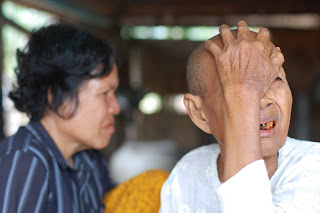Thursday, February 26, 2009
Expertise needed. . .
Monday, February 23, 2009
User Research

Kandal
My last two days of field work were about a week and a half ago in Kandal—a province about a half hour outside Phnom Penh. All villagers this time. Three each day. We tried to reach dry latrine, wet latrine and non-latrine households in order to better understand the motivations of each. I won’t go into it in much detail now, but did want to share more of my photos to give you a better sense of the people and the environment.





Tuesday, February 17, 2009
Svay Rieng

Participant recruiting (normally the bane of any researcher) is remarkably simple here. We just walk around the villages until we see someone with a latrine that looks interesting then go up to their house and ask if they want to talk. Everyone spends 98% of their time outside, so they’re easy to find. And everyone has been ridiculously generous with their time, very open to talking about defecation (something with a pretty strong taboo back west) and really funny and enjoyable to interact with. Physically, the people are amazingly beautiful and have great character, especially the elderly and the children. My photography doesn’t do them great justice, but here are some of the people we met:






The interviews mostly last an hour and are almost completely out of my hands. They happen all in Khmer and for every 5 minutes of talking, I get about 30 seconds of translation. I’m not getting a lot of the nuance, but I am getting something. I’m counting on the rest of the team to bring out the nuanced insights during the discussions this week.
Some of the latrines we saw. . .
Saturday, February 14, 2009
CLTS
End of last week I learned about Community Led Total Sanitation (CLTS). It’s a movement that’s swept through the sanitation development sector in the last three or four years. It emerged in response to the realization that the decades of subsidizing latrine building was not going to solve the sanitation issue. There wasn’t enough money to build latrines for everyone, and those that were built were often left unused, locked or ended up broken. People who’d been defecating in the bush for generations weren’t going to completely change their behaviors just because there was now a latrine. In most cases, the villagers didn’t believe in the need for having a latrine. If there’s no belief, there will be no behavior change.
CLTS was pioneered in Bangladesh by Kamal Kar. If you want to see a video about it, watch this. It’s pretty interesting. In short, CLTS is a behavior change model based on generating disgust and shame. It’s about getting people to come to the realization that they are eating and drinking shit—their own shit and other people’s shit. Only later in the process is health brought up—in terms of diarrheal illness that the community experiences and health costs related to them. But primarily, it’s about eating shit. The language used is coarse--shit, shit, shit. Embarrassing people is encouraged.
Interestingly for us, CLTS is repeatedly adamant about not explicitly advocating for the construction of latrines or for specific latrine models—people are supposed to come to the realization on their own that latrines will help them stop eating shit. People are supposed to come up with their own solutions and designs to building latrines. Note, however, that CLTS is not completely consistent with this because during a CLTS event, CLTS moderators draw a simple latrine as an example (albeit late in the day during the CLTS event). And the CLTS training manual mentions that moderators can “share and explain about low and moderate cost latrine options. . . including the sources of their availability. . .” I think that the CLTS theorists just don’t want to lead the whole effort with latrine designs and latrine advocacy.
Anyhow, CLTS is the big buzz amongst the Cambodian Ministry for Rural Development and the NGOs. Though it has a few rules, CLTS is mostly open source, so each government and each NGO in each country has freedom to adapt it to more closely match their target populace and their own ideals. I’m pretty certain the Ministry for Rural Development has made a few changes to the methodology, but I’m still tracking them down. Not sure how major they are. One thing I’m fairly certain of is that the resistance of CLTS to advocate for certain latrine designs is leading to some problems in Cambodia. Amazingly enough, it turns out that if you don’t know how to properly built something, you usually do a pretty crappy job the first time. And the second time. And the third time. Ever tried to build a chair? How do you think your first one would come out?
The CLTS insistence that villagers develop their own latrine designs and constructions is, in my opinion, flawed. Most villagers are building dirt pit dry latrines. They’re cost-free (minus self-labor) but they’re far from ideal for many reasons that I’ll get to in a later post. But for now, it’s enough to know that a significant number of the dry pits built as a result of CLTS efforts have been collapsing due to soil instability during the wet season. The villagers affected are left without proper sanitation for the rest of that wet season and have to redig a new pit the following year. Often, the pit isn’t redug and the villagers return to open defecation. When it is redug, it often collapses again the next wet season. It’s not a sustainable sanitation approach here in Cambodia. I’m not sure how to marry the IDE technology solutions with the agnosticism of CLTS, but I am sure that it needs to be done.
By wanting a $10-20 initial price-point, are we fighting the CLTS efforts? How do we say that our $10-20 latrine is the first step when CLTS is saying that a hand-made dry pit is the first step? Do we need a zero price-point (or $2-$5) design included in our material (i.e., a dry pit design with a dirt pit—maybe lined with local free bamboo—covered with a bamboo and clay slab with a thatch superstructure—cash expenditure only for nails and for a pipe for pit ventilation)?
I also wonder how this might affect the IDE marketing effort. How closely will IDE work with CLTS? Will IDE be in the villages at the same time as CLTS folks or shortly after? When will IDE share its designs and how will that fit in with the CLTS philosophy? Should IDE’s marketing efforts echo the same coarse language and push some of the same buttons as CLTS (disgust and shame)? Given our premise of an upgradeable latrine (a stair-step model, if you will), is the first big step about not eating shit?
Kampot








Tuesday, February 3, 2009
Observation planning. . .
Monday, February 2, 2009
Kickoff
Last Wednesday, we had our project kickoff. We had about fifteen people from many different organizations: World Bank Water & Sanitation Program, Ministry of Rural Development (MRD), Future Cambodia Fund, LienAid, GRET, Rainwater Cambodia. . . Mike (from IDE) gave an intro to the project and the Demand Assessment and Supply Chain work that IDE has already done. I gave a short intro to IDEO and then we did a few activities. I had everyone do a braindump on who in Cambodia is doing anything regarding sanitation, with specific emphasis on folks doing stuff related to latrine design. I’ve since followed up with a number of those people and have had or will have meetings with them to learn what they’re up to.
We also talked a lot about Community-Led Total Sanitation (CLTS)—an intensive outreach program originated in Bangladesh that attempts to achieve open defecation free villages purely through education about the positive impact of proper sanitation. To learn more, check out this video. They’ve had great success there, and the MRD has had pretty good success here in Cambodia in its first three years of the effort. CLTS doesn’t advocate for any particular latrine design, and one flaw in the program as experienced by MRD is that the majority of participants tend to build simple dry-pit latrines (a hole in the ground with a wood or bamboo slab over it). These have been collapsing during the wet season due to soil instability, which leaves people without a latrine in the wet season and forces them to redig the pit every dry season—neither of which is good. Seems that even with the simplest of latrines, some reinforcement of the pit will be required.
We then did a quick brainstorming exercise to draw out everyone’s initial ideas of what the final solution will be. There were some great ideas that I’m sure will stick with us to the end.

Finally, we got commitment from a core team that will work with me more intensely thought the project: Chhoeurn (MRD), Savath (IDE), Satya (IDE), Sopheak (LienAid) and Hengly (Rainwater Cambodia). None are engineers, none are designers, none are ethnographers!!! But they are all eager to learn and to work on solving this problem. Should be fun.



Market day. . .
Thought some of you might enjoy these photos from a market I went to on Sunday. Was in one of the neighborhoods of Phnom Penh and, from the looks I was getting, not often frequented by westerners. The market sold pretty much everything—meat, fish, fruit, veggies, clothes, watches, jewelry, packaged foods, grains, housewares (bowls, cups, etc), soaps and detergents, shoes. . . you name it. In the humid, hot day, the smells were intense. And in the fish/butcher area, I was regretting wearing sandals. . .























